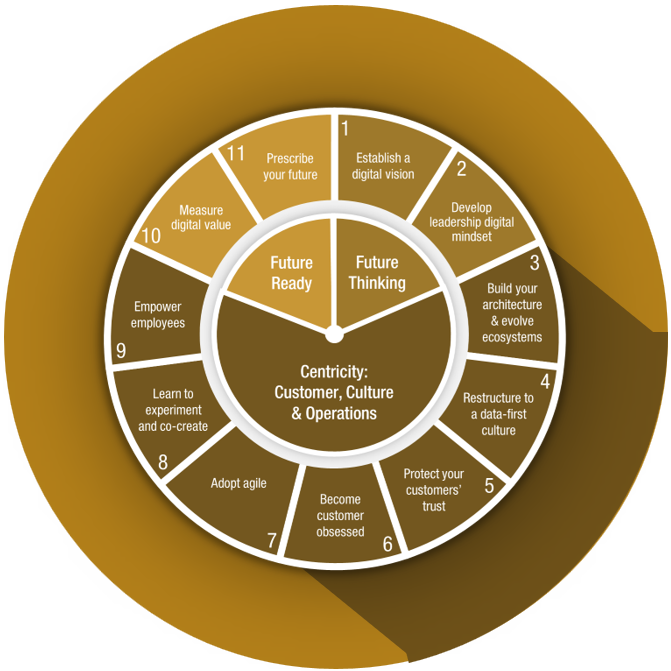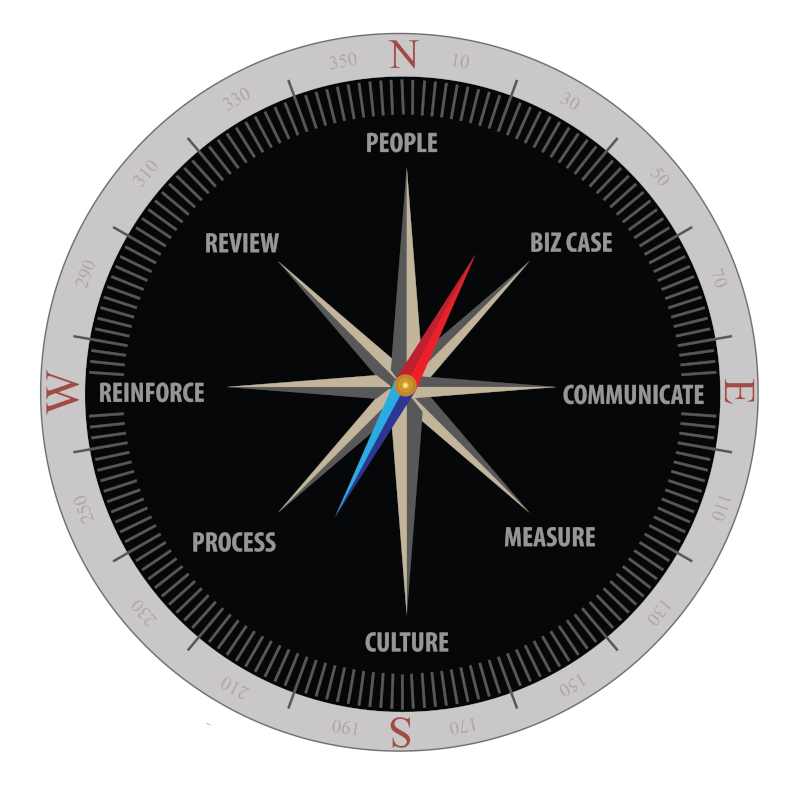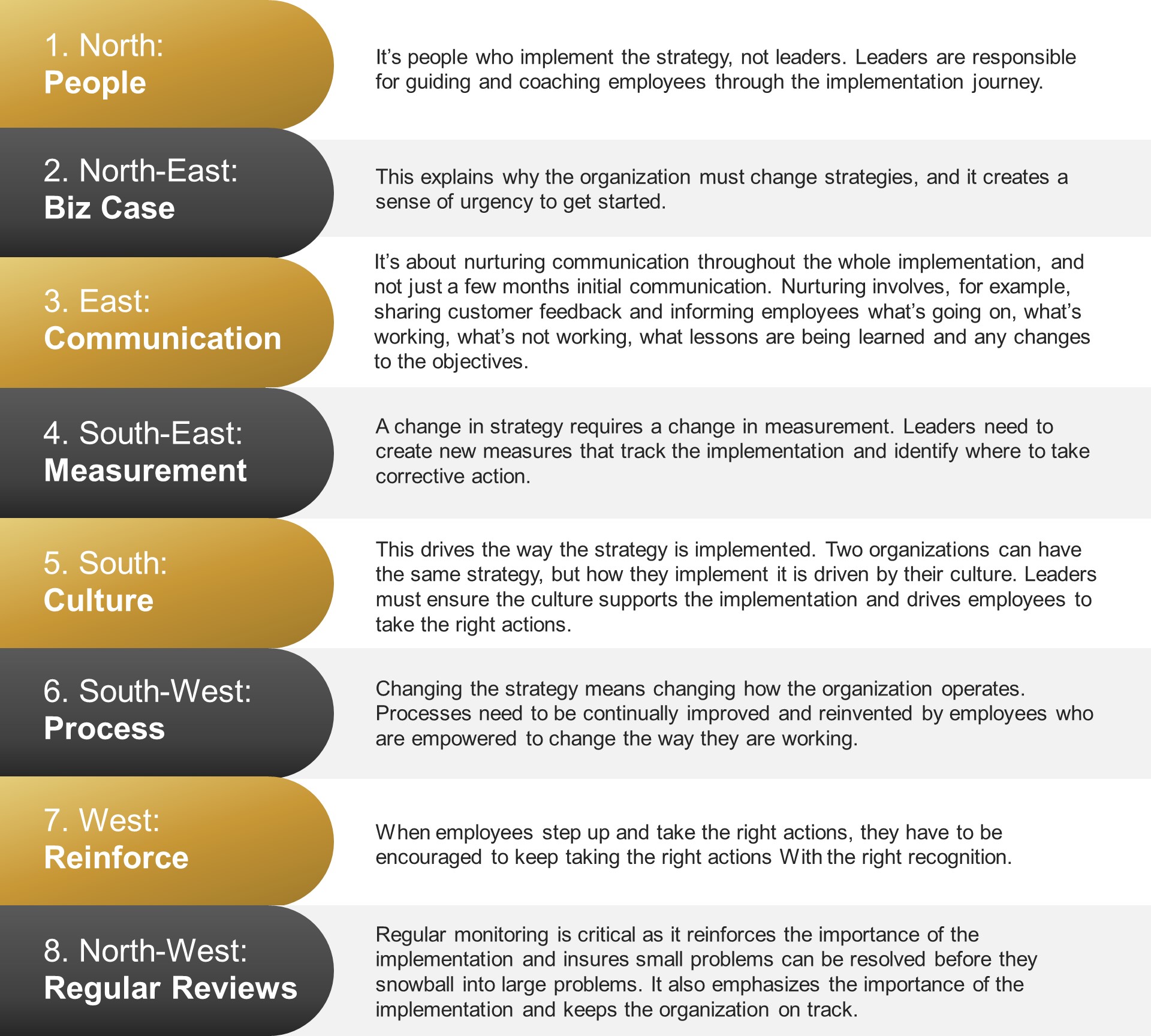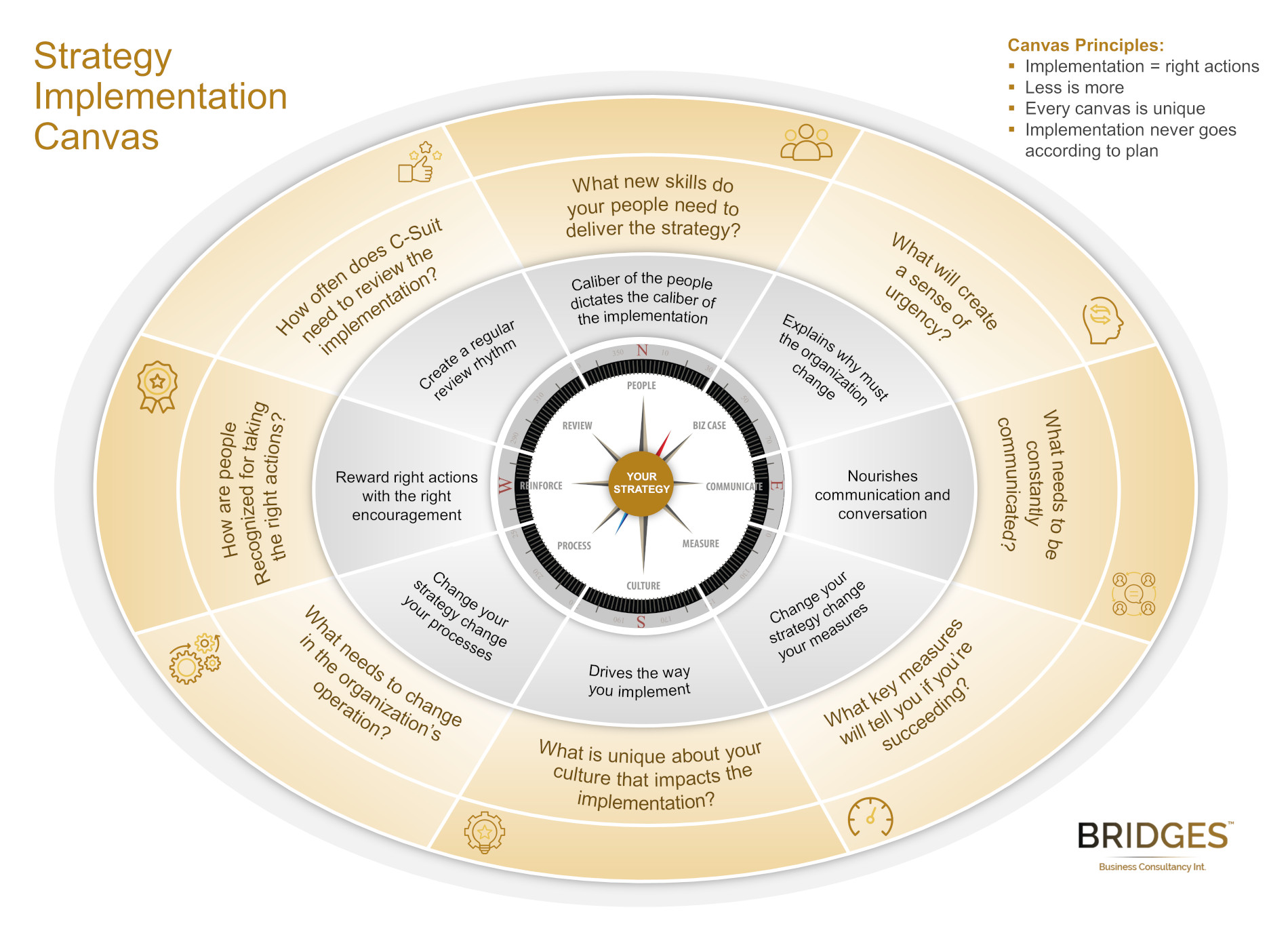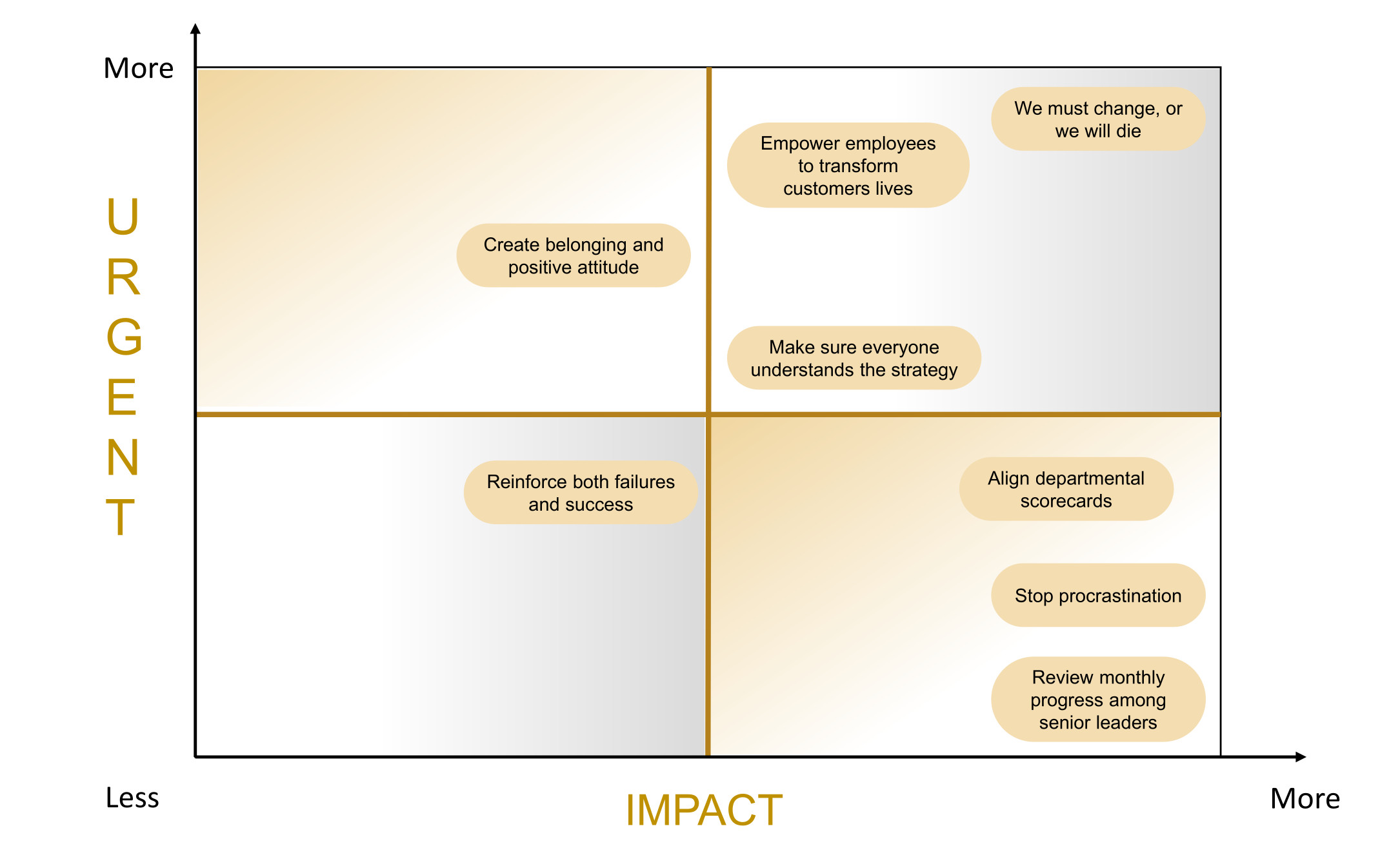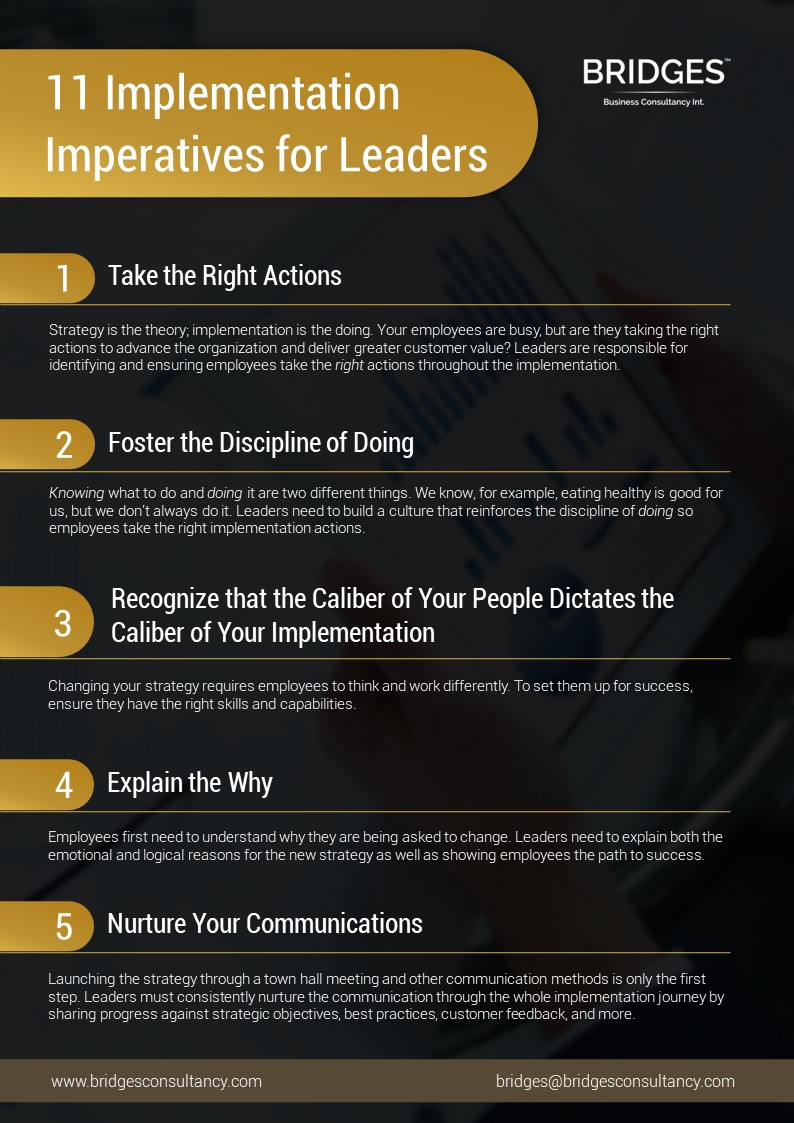Implementation Consultancy Approach
Bridges specializes in strategy and digital implementation.
At Bridges, our approach uniquely empowers your team, setting us apart from typical consultancies. We believe that the key to successful strategy implementation lies in ownership by your people. Our role is akin to a personal trainer in a corporate gym – we guide, correct, and provide a comprehensive suite of tools, templates, and insights. However, it’s your team that does the heavy lifting, ensuring they fully embrace and lead the implementation.
Within an 18-month collaboration with Bridges, we aim to make your organization self-reliant, rendering our services redundant. This approach is rooted in a fundamental belief: transformation in leadership thinking is essential for successful implementation. We impart the critical knowledge and intellectual property your team needs to change traditional methodologies and achieve lasting success.
The current generation of leaders is well-versed in strategic planning but often finds itself at a loss when it comes to implementation. This prevalent ‘Strategy Implementation Skills Gap’ has led to a startling reality: according to our research dating back to 2000, two-thirds of strategic implementations fail. At Bridges, we’re committed to changing this narrative by equipping leaders with the skills necessary to bridge this gap and turn strategies into tangible successes
Leaders today need both the ability to craft strategy and the skill to implement it.
Despite their best intentions between thought and action, leaders often lose the impetus during the journey. Bridges supports leaders to:
1. Develop the discipline of “doing” across the whole organization.
By definition, changing an organization’s strategy means changing the way employees work. To ensure they participate in the implementation, they need more than a 45-minute town hall meeting that launches the new strategy. Mostly, they need continuous support, reinforcement, and the tools to develop the discipline of taking the right actions.
As an example, we know that eating healthy and exercising are the right things to do. But we don’t always do it. Working with Bridges instils the discipline of taking the right actions throughout the organization.
2. Avoid repeating past mistakes.
Leaders habitually repeat past mistakes, which is a critical challenge to implementing strategy. They continue to adopt the same methodology and rely on old ones, even though they have failed before.
How can leaders avoid this outcome? At the initial stages of implementation, they identify why other attempts have failed in the past and what needs to be done differently.
Bridges supports leaders in avoiding past mistakes and then changing their thinking and approach.
3. Taking the right actions.
In the dynamic world of strategy implementation, the challenge isn’t just about identifying new actions; it’s about integrating them seamlessly into the existing workflow of your employees. They are already navigating through their routine tasks, and the addition of implementing a new strategy demands not just their time but their adaptability and commitment.
The crux of successful strategy implementation hinges on this pivotal shift in actions. Without altering their current practices, employees, by default, continue to drive the old strategy, inadvertently hindering progress. It’s essential, therefore, to not only delineate what needs to be done differently but also to ensure that these new actions are being effectively and consistently implemented.
At Bridges, we specialize in guiding organizations through this transformative journey. Our focus is on turning strategic thought into tangible action and elevating plans into real-world achievements. By partnering with us, your organization can smoothly transition from the conceptual stages of planning to the practical aspects of doing, ensuring that every step taken is a step towards success.
Strategy is About Making the Right Choices.
Implementation is About Taking the Right Actions.
To support people in implementing strategy, Bridges has developed three proprietary frameworks:
Implementation Compass™
Navigate Your Implementation Journey with Bridges’ Implementation Compass™
At Bridges, we understand the intricacies of strategy implementation. To guide you through your implementation journey, we have developed a proprietary tool: the Implementation Compass™. This framework is the result of extensive research conducted since 2000, delving into the strategies that proved effective (and those that didn’t) in the realm of implementation.
Our findings revealed eight critical areas that distinguish successful organizations. These insights have been distilled into our unique framework, which is designed to provide clear direction and pinpointing the optimal actions.
The core of the Implementation Compass™ is these eight pivotal areas:
Part Two of this book delves into each of the eight areas and provides use cases, examples, stories, neuroscience, and best practices.
The Compass Celebrates 20 Years
The Compass is celebrating 20 years since it was published in my first book on this subject called Bricks to Bridges–Make Your Strategy Come Alive. The eight areas that make up the Compass came from our research and client work. For over these two decades, the framework has not changed apart from modernizing its look.

Implementation Compass quotes – Download
Ticking Clock Model ©
Master digital transformation using the Ticking Clock Model©.
Leaders often face the challenge of comprehending the multifaceted nature of digital transformation and its impact on customers and business operations alike. The Ticking Clock Model, a product of extensive global research and collaboration, offers clarity and direction in this complex landscape.
This model is the culmination of insights gathered from interviews with 1,847 leaders across North America, Europe, and the Asia Pacific in 2019, further refined by additional research involving 2,138 interviews across four continents in 2024. Developed in partnership with Performance Works, the Ticking Clock Model not only elucidates how various elements of digital transformation interconnect but also provides a structured approach for navigating this journey.
For leaders seeking to comprehend the multiple moving parts in digital transformation, this model is particularly invaluable. It outlines three strategic stages and 11 operational steps, offering a clear and comprehensive roadmap for successful digital adoption and transformation.
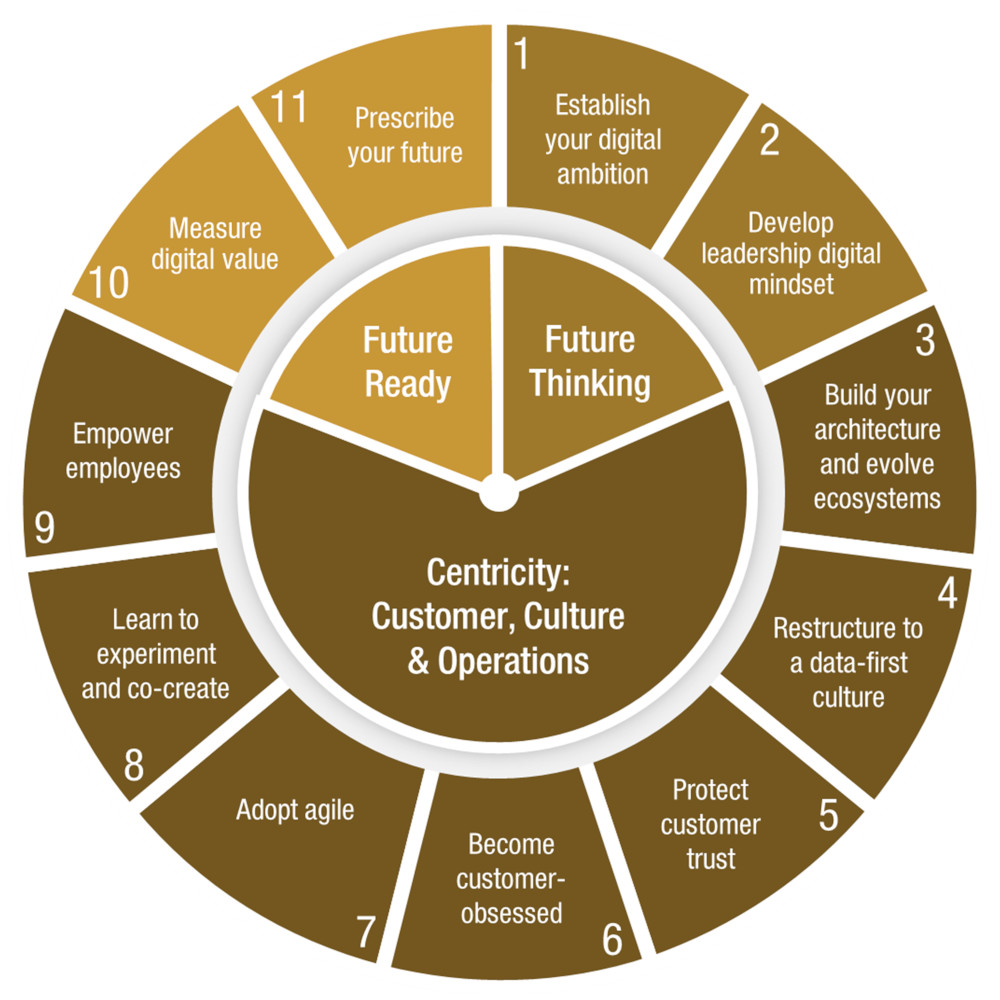
Ticking Clock Model©
Three Strategic Stages
The three strategic stages in the inner circle of the Ticking Clock Model are:
1. Future Thinking
Establish a clear digital ambition for your organization and develop the right leadership mindset.
2. Centricity Around Customer, Culture and Operations
Identify the impact of digital on your organization’s business model. It is not about tweaking your business model but more often than not complete business model transformation which starts and ends with the customer.
3. Future Proofing
Future proof your organization by constantly measuring the progress being made and building long term sustainability.
After discussing the three strategic stages, then leaders focus on the 11 operational steps.
11 Operational Steps
The 11 operational steps are in the outer circle of the Ticking Clock Model. Key discussion questions are included for each step.
| Steps | The leadership discussion question: | Description |
|---|---|---|
| 1. Establish a digital ambition | “How can the organization leverage digital to add greater value to the customer, and what needs to change within the business?” | The digital ambition provides clarification, direction and alignment across every part of the organization and directs the digital investments. |
| 2. Develop a leadership digital mindset | “What needs to change in a leader’s mindset and behavior to deliver the digital ambition?” Today’s thinking and approach will not sustain an organization for tomorrow. | Leaders need to let go of legacy leadership and embrace and embed what it takes to lead in a digital world. |
| 3. Build technology architecture & evolve ecosystems | “What and where can we build greater customer experience and leverage new opportunities?” | The CAPEX investment at the start of a digital journey can be high, so it’s critical to make sure the organization has the right technology roadmap. |
| 4. Restructure to a data-first culture | “What does a data-first culture look like, and how do we integrate it across the whole organization?” | Achieving a data-first culture is not as much about making data available as it is about changing the mindset of how employees work. |
| 5. Protect customer trust | “How do we continue to ensure customer trust?” It’s estimated that more systems get hacked than don’t get hacked. | Customers need to be reassured about the safe-guarding of their personal information and how it is being protected and used. |
| 6. Become customer obsessed | “How are changing customer needs driving our business model?” | The key difference to being customer obsessed in a digital world is the combination of a data and customer journey mapping that allows organizations to leverage customer science and create mass customization. |
| 7. Adopt agile | “What needs to transform internally to respond faster and more effectively to the changing marketplace and customer requirements?” | Agile is the latest approach for internally improving an organization. It enables organizations to move from being built-to-be-stable to being faster and aligned in their ability to quickly respond to changing markets and customer needs. |
| 8. Learn to experiment and co-create | “What needs to change in our organization’s culture so that people feel safe to experiment and fail?” | Organizational culture in a digital world may go through a radical shift. Leaders recognize that if employees are not failing, they’re not experimenting, and if they’re not experimenting, they’re not innovating. Therefore, leaders now encourage employees to fail. |
| 9. Empower employees | “How can we create the right environment for employees to step up and take more responsibility?” | Digital ambition is crafted at the top and implemented from the bottom up. The leaders’ role is to empower their people in the right ways and create the right environment. |
| 10. Measure digital value | “How do we measure and demonstrate digital value?” | To be Future Ready, leaders need to identify new measures such as scalability and paperless that track the performance of digital transformation and drive corrective action where and when required. |
| 11. Prescribe your future | “What is our next strategy?” | When everything is going well, it’s time for leaders to prepare the next strategy. This is happening more frequently than ever before. |
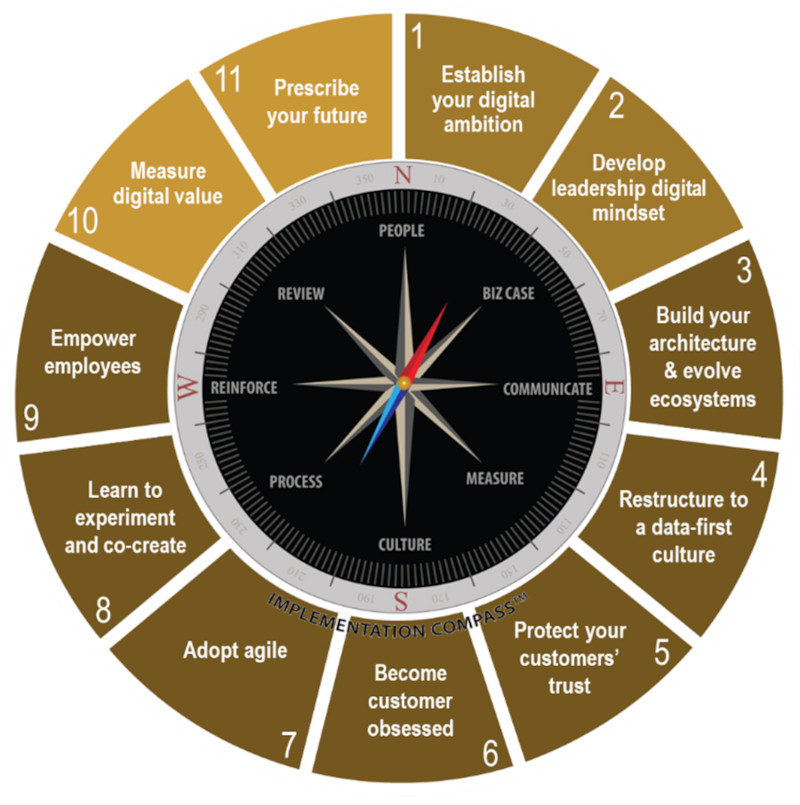
Implementation Canvas©
The Implementation Canvas generates the right actions at the organization level.
It’s designed to facilitate leadership discussion on further identifying the right actions the organization needs to take and prioritizing them. It builds on the work done in assessing the organizations’ readiness to implement and builds on the identification of the right actions from the Implementation Compass.
- At the heart of the Canvas discussion is the organization’s strategy.
- The second circle captures the eight areas of the Implementation Compass.
- The third circle highlights the sound bite for each area of the Compass.
- The penultimate circle highlights the critical discussion questions for each of the eight areas to achieve excellence and execution.
- The final circle is where the leaders enter the right actions for their organization.
While conducting the Canvas, leaders keep in mind its four principles:
- Implementation equals right actions.
- Less is more.
- Every Canvas is unique.
- Implementation never goes according to plan.
The leaders brainstorm on the critical discussion questions for each of the eight areas and then prioritize the actions they identify against their impact and urgency.
Prioritization of Actions
Leaders reflect on the results of the organizations readiness to implement along with the brainstorming from the Canvas. They then complete the Prioritization of Actions two-by-two. This reflects the level of impact and urgency for their organization.
When initiating the rollout of a strategy everything seems urgent and this is where discipline is required by leaders (and where many implementations fail right from the start as an organization tries to do too much, too soon, and too quickly). Leaders prioritize the right actions. This clarifies across the organization in more detail how the implementation will be rolled out and also allows leaders to further translate the strategy to their employees and allocate the required resources and time. The diagram below shows a prioritization of actions sample.
“Strategy is about making the right choices. Implementation is about taking the right actions.”
“Strategy can be defined as the thinking and implementation as the doing.”
“Leaders are guilty of repeating the same implementation mistakes they have previously made.”
“Knowing and taking the right actions move organizations from strategy creation to strategy implementation.”
“You can outsource the crafting of a strategy but not its implementation.”

